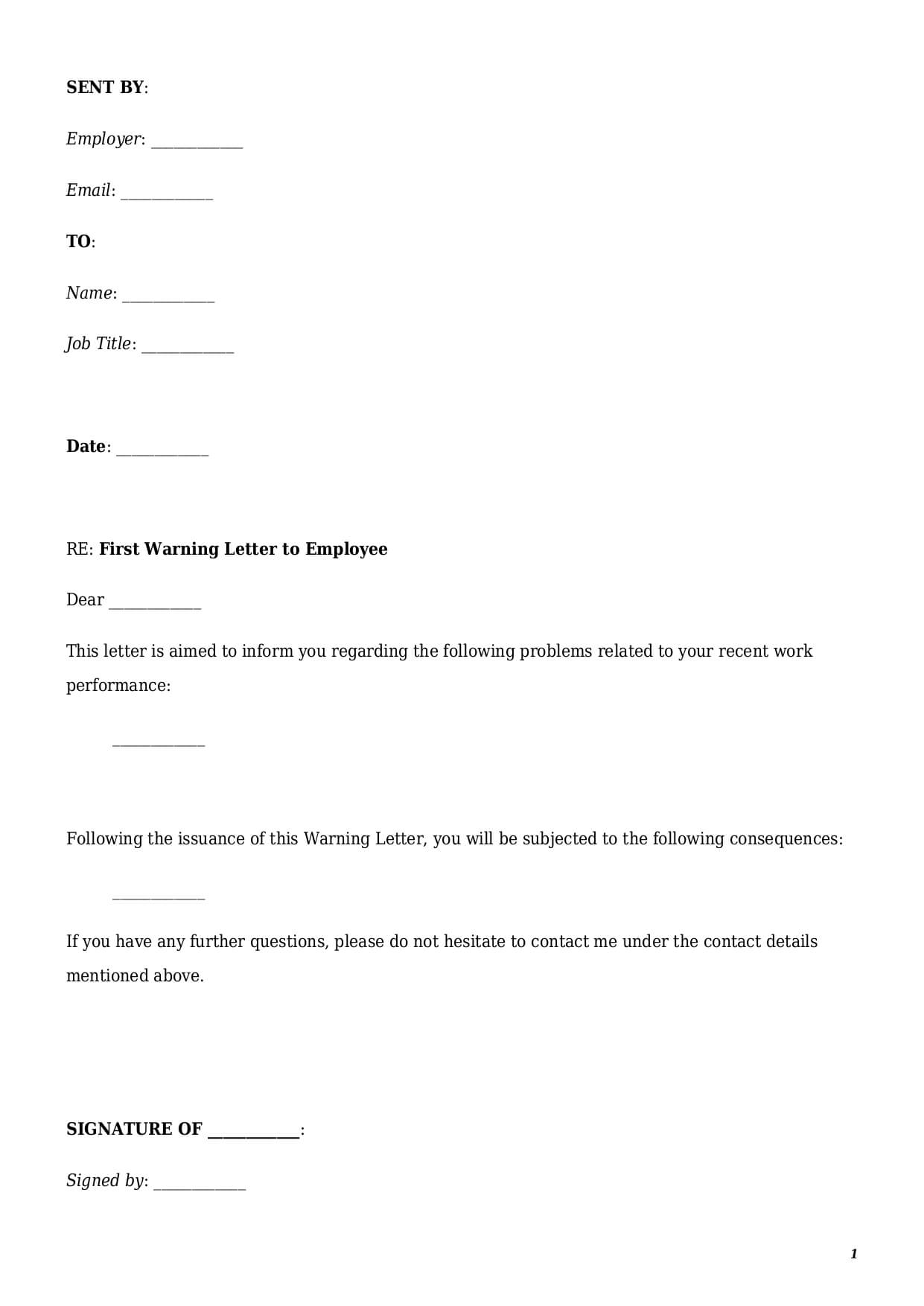Warning Letter to Employee
Reviews


What is a Warning Letter to Employee?
A warning letter to employee is an official legal document issued by an employer to inform an employee about unacceptable working behavior, low performance, or violation of the company’s internal policies. This document serves as an official notification to an employee and as a ground for potential disciplinary measures or termination of employment relations.
A warning letter to employee is being issued in the following cases:
- unprofessional or unethical behavior. A warning letter to employee for unprofessional behavior is one of the most popular warnings that address inappropriate conduct at the workplace and may include violent behavior, insubordination, etc.
- disciplinary issues. This type of employee’s behavior may include repeated lateness, failure to follow the employer’s safety guidelines or recommendations, and many more.
- other violations of workplace rules. This type of action may relate to an employee who is involved in a workplace harassment or discrimination incident.
The employee warning letter is aimed to correct or improve the employee’s performance rather than punish it. It can apply to different kinds of employees—remote workers, part-time employees, etc.
A warning letter can be issued only in employment relations. This is when an employee is officially employed and has an effective employment contract in place. A client under an independent contract agreement or services agreement cannot issue a warning letter to service providers, for instance.
How to Draft a Sample Warning Letter to Employee?
When creating a sample warning letter to employee use those essential tips below:
Make a preliminary internal investigation
If you are an HR person or another person within an employer’s organization authorized to issue employee warning letters, make an internal investigation first. Try to find out as much information as possible about an employee affected and incident(s) that happened. Try to align an employee’s behavior with an employer’s internal policies and regulations like workplace harassment, disciplinary policy, employee handbook, and more. The listed documents could be helpful to identify which conduct can trigger disciplinary measures.
State the Purpose Clearly
The best practice is to indicate directly in a letter’s title that this is a warning letter to employee. Using direct language helps to eliminate ambiguity and take conversation straight to the point.
Describe the incident in detail
Specify the exact behavior or performance issue that led to the warning. For instance, when writing a warning letter to employee for unprofessional behavior, describe the inappropriate actions—e.g., disrespectful communication, constant lateness, inappropriate attire, bullying or intimidation of other colleagues, and so on.
It is legally wise to make direct references to an employer’s internal policies defining such conduct as unwelcome or unsolicited. Besides that, it also helps an employee to see that accusations raised in the text of the warning letter are based on internal regulations.
Mention Previous Communication
If this is a first warning letter to the employee, yes, this section can be omitted. However, if the same employee has previously been spoken to about the same misconduct some time ago, this should be stated directly in the text of the letter. Depending on an employer’s internal regulations, if an employee is being issued the same warning letter three times in a row and the situation does not improve, it becomes a ground for termination of an employment contract.
Outline Expectations and Consequences
Every employee letter template should clearly outline expectations of what should be done or improved in the future. If an employee’s performance or working metrics are an issue, in that case a warning letter to employee should define the KPIs an employee should achieve. If the reason for sending this letter is the employee’s unprofessional behavior, in that case an employee should be informed of actions to be stopped.
Finally, an employee should be communicated about consequences should an employee fail to improve their behavior. Those consequences may include termination of employment contract, failure to receive an annual bonus, cancellation of promotion, and so on.
What Are the Key Components of a Warning Letter to Employee?
A strong employee warning letter template should include several essential components to make sure the document is legally valid:
Introduction
- The letter should be placed on the official company’s letterhead containing the following information:
- Employer’s name, including the name of a department that is authorized to issue such a letter;
- Employer’s address and contact details like email or phone number;
- Date of issuance of the letter;
- Employee’s full name and job title. For big organizations, the name of a department or unit in which an employee is currently employed should also be included;
- Letter’s topic, e.g., “1st Warning Letter to Employee for Unprofessional Behavior” or “Employee Warning Letter for Attendance Issues.”
Detailed Description of the Issue
Detailed description of disciplinary incident(s), including:
- The dates and places where such incidents took place;
- If available, information about witnesses who can confirm the behavior in question;
- Reference to any company policies or codes of conduct violated;
- Mention of any prior discussions or informal warnings (if any).
Further Improvements
Outline what corrective actions are expected from the employee. If needed, an additional supervisor could be assigned to an employee to help him or her to achieve the necessary improvements.
The timeline for improvements is an essence. Thus, the warning letter to the employee should state the exact period of time within which an employee’s performance should improve. Such a timeline can be from a few weeks to a few months, depending on the complexity of the issue.
Another vital component of every employee warning letter template is consequences. The text of the letter should clearly state what will happen if an employee fails to improve their behavior.
Acknowledgement Section
It is a legal requirement that a warning letter to an employee should be communicated, signed, and acknowledged by the employee in question. By putting their signature, an employee confirms that he or she is aware of an issue, areas for improvement, and possible consequences.
A warning letter to an employee should also be signed by an employer or their authorized representative (e.g., head of HR).
Table of content
Frequently Asked Questions (FAQ)
-
1. What is a warning letter for unprofessional behavior?
A warning letter for unprofessional behavior is an official warning issued by an employer that reports an incident of an employee’s unprofessional behavior. Unprofessional behavior in the workplace may include spreading rumors or gossiping. bullying or harassing other colleagues, misusage of the company’s time and resources, inappropriate use of language, romantic advances, or other unethical behavior.
-
2. How do I give an employee a written warning?
An employee should be informed that a warning letter has been issued in their name. The best way to inform them is to make them read the warning letter and put their signature on it. By doing so, an employer will have written proof of acknowledgment of the warning letter from an employee.
-
3. What is a final written warning?
A final written warning is an official communication from an employer stating that an employee’s behavior or performance is a serious issue, and if an employee won’t be able to improve it, an employment contract is to be terminated.

Looking for something Different?
Start typing to find out our collection of legal documents and contract templates
